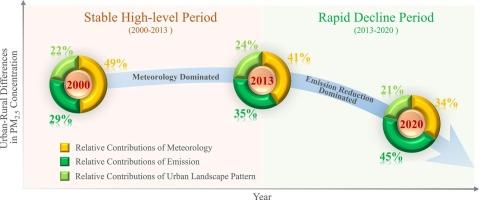塑造中国历史和未来PM2.5城乡格局的关键因素
IF 11.2
1区 社会学
Q1 ENVIRONMENTAL STUDIES
引用次数: 0
摘要
2000年以来,中国的快速城市化和减排努力显著改变了排放、下垫面和气象条件,改变了PM2.5的城乡分布。然而,各种因素对历史PM2.5城乡格局的相对贡献以及影响未来格局的敏感因素尚不清楚。本研究量化了2000 - 2020年中国299个城市排放、城市景观格局(ULP)和气象对PM2.5城乡差异(URD-PM2.5)的相对贡献,并进一步确定了改变历史URD-PM2.5的主导驱动因素和重塑未来URD-PM2.5的敏感因素。研究结果表明:2000 - 2020年的pm2.5演变可分为两个典型时期:稳定高水平期(SHP, 2000 - 2013)和快速下降期(RDP, 2013-2020)。在此期间,排放对URD-PM2.5的相对贡献持续增加(全国从29%增加到45%),而气象的相对贡献持续减少(全国从49%减少到34%)。在RDP期间,排放逐渐取代气象成为主导驱动因素。ULP的相对贡献保持稳定。此外,173个城市的URD-PM2.5对排放的敏感性增加,中国南方和西南地区的110个城市对ULP的敏感性增加,而中国东北地区的16个城市对气象的敏感性增加。这些发现突出了不同时期排放和气象对PM2.5城乡格局的不同贡献,并建议未来需要根据城市的敏感因素,制定更有科学针对性的政策,以协同改善城乡空气质量。本文章由计算机程序翻译,如有差异,请以英文原文为准。

The key factor in shaping the historical and future PM2.5 urban-rural pattern in China
Since 2000, rapid urbanization and emissions reduction efforts in China have significantly reshaped emissions, underlying surfaces, and meteorological conditions, altering the PM2.5 urban-rural distribution. However, the relative contributions of various factors to historical PM2.5 urban-rural patterns and the sensitive factor shaping future patterns remain unclear. This study quantified the relative contributions of emissions, urban landscape patterns (ULP), and meteorology to PM2.5 urban-rural differences (URD-PM2.5) across 299 Chinese cities from 2000 to 2020, and further identified the dominant drivers changing historical URD-PM2.5 and the sensitive factor reshaping future URD-PM2.5. The results show that URD-PM2.5 evolution from 2000 to 2020 can be divided into two typical periods: the Stable High-level Period (SHP, 2000–2013), and the Rapid Decline Period (RDP, 2013–2020). During these periods, the relative contribution of emissions to URD-PM2.5 consistently increased (nationally from 29 % to 45 %), while that of meteorology decrease continuously (nationally from 49 % to 34 %). And emissions gradually replaced meteorology as the dominant driver during RDP. The relative contribution of ULP remained stable. Furthermore, URD-PM2.5 in 173 cities was observed to become increasingly sensitive to emissions, 110 cities in southern and southwestern China are increasingly sensitive to ULP, while 16 cities in northeastern China are increasingly sensitive to meteorology. These findings highlight the different contributions of emissions and meteorology to PM2.5 urban-rural patterns at different periods, and suggest more scientifically targeted policies tailored to specific cities' conditions are needed according to their sensitive factors in future to collaboratively improve urban-rural air quality.
求助全文
通过发布文献求助,成功后即可免费获取论文全文。
去求助
来源期刊

Environmental Impact Assessment Review
ENVIRONMENTAL STUDIES-
CiteScore
12.60
自引率
10.10%
发文量
200
审稿时长
33 days
期刊介绍:
Environmental Impact Assessment Review is an interdisciplinary journal that serves a global audience of practitioners, policymakers, and academics involved in assessing the environmental impact of policies, projects, processes, and products. The journal focuses on innovative theory and practice in environmental impact assessment (EIA). Papers are expected to present innovative ideas, be topical, and coherent. The journal emphasizes concepts, methods, techniques, approaches, and systems related to EIA theory and practice.
 求助内容:
求助内容: 应助结果提醒方式:
应助结果提醒方式:


